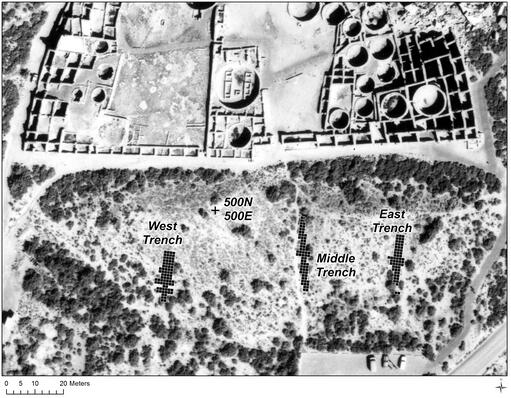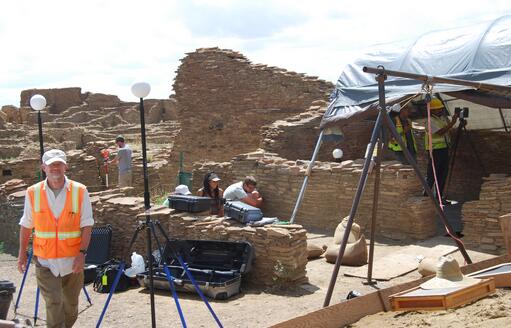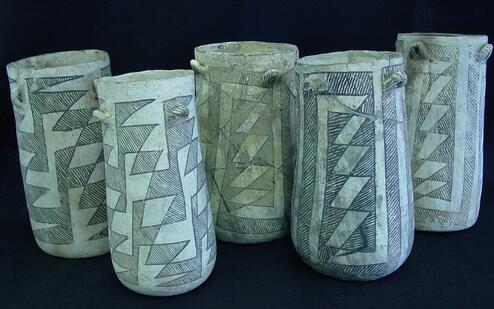Investigating Water Control, Exchange, and Ritual through Excavations of Pueblo Bonito, Chaco Canyon, New Mexico
From:Shanghai Archaeology Forum NetWriter:Date:2017-12-10
Pueblo Bonito is a large masonry town, or pueblo, located in Chaco Canyon in northwestern New Mexico at an elevation of around 1890m. The site is part of the Chaco Culture National Historical Park, which was designated a UNESCO World Heritage Site, based on a concentration of over 4000 sites spanning the time period from Paleo-Indian to historic Navajo, and particularly those that form the core of what is called the Chaco Phenomenon: multi-storied masonry pueblos with adjacent roads that were part of an elaborate cultural system spanning much of the Four Corners area of the U.S. Southwest between about A.D. 950 and 1140.Pueblo Bonito is among the largest and most completely excavated sites in the U.S. Southwest, encompassing around 600 masonry rooms up to four stories in height, as well as around 37 semi-subterranean masonry-lined structures called kivas and used primarily for ritual activities. Two major projects excavated most of Pueblo Bonito. From 1896-1899, the Hyde Exploring Expedition (HEE) excavated around 200 rooms under the supervision of Richard Wetherill and George Pepper. The National Geographic Society (NGS) sponsored an excavation of much of the remainder of the site under the supervision of Neil Judd between 1921 and 1927. Although most of the site was excavated by 1927, questions remain concerning the construction sequence of the site, whether water control was necessary for supporting such large sites in this inhospitable environment, the scale of interaction with surrounding and distant population, and the nature of leadership within the pueblo.

In 2004, we began a series of projects that address research questions by reopening parts of Pueblo Bonito previously excavated by the HEE or NGS projects. All of these projects involved consultation with the Native American tribes who are the descendants of the inhabitants of Chaco. All of the projects also involved undergraduate and graduate students (including many Native American students), as well as technical specialists. With funding from the National Science Foundation (NSF) and NGS, Wills reopened portions of three trenches originally excavated by the NGS through and between the two trash mounds south of Pueblo Bonito between 2004 and 2007. Our goal was to relocate deeply buried channels noted under the mounds to understand the relationship of water control systems to the development of Pueblo Bonito during the A.D. 1000s. The project aimed to answer this by recording the stratigraphy and taking radiocarbon and environmental samples. This project revealed that the residents of Pueblo Bonito constructed a large diversion channel just south of the town during the 11th century A.D. Sediments in the channel reflect repeated episodes of flooding, suggesting that it was built primarily to divert floodwaters away from the habitation site while providing water for construction and domestic use. It was destroyed by the late A.D. 1000s.
Within a few hours of reopening the trenches, we realized the NGS crews had pushed most of the artifacts from their excavations back into the trenches, and that we were now responsible for over 200,000 objects. With additional funding from NSF, Crown hired twelve graduate and undergraduate students to analyze this material between 2007 and 2009. The results of the project were recently published in The Pueblo Bonito Mounds of Chaco Canyon, edited by Crown. Among the ceramics were five that appeared to be of a rare form found primarily at Pueblo Bonito that archaeologists call cylinder jars. These tall, straight-sided jars sometimes have black designs on the white background and sometimes are all white or red. Crown was curious whether these might have been used as the Maya used this form, to drink chocolate, so she and collaborator W. Jeffrey Hurst performed High Performance Liquid Chromatography-Mass Spectrometry on the five sherds from the trash mounds, finding chocolate residues in three of them. This discovery demonstrated long-distance exchange of cacao from the sub-tropics of Mesoamerica to the American Southwest. The residents of Pueblo Bonito acquired not only cacao from Mesoamerica, but also scarlet macaws, copper, pseudo-cloisonné, and other exotic bird species and feathers from the south. What did they give in return? We do not know, but several scholars have suggested that turquoise ornaments were exchanged for Mesoamerican exotics.

The discovery of chocolate residues led Crown to request permission to reopen Room 28 in Pueblo Bonito, where 112 of the roughly 200 known cylinder jars were found in 1896. Prior to excavating, Ground Penetrating Radar verified that the deposits were intact and that charred posts remained in place on the lower floor. With funding from the National Endowment for the Humanities (NEH) and NGS and a crew of six graduate and undergraduate students, we re-excavated the room over a six-week period in 2013. We set out to determine how and when the room burned, whether the cylinder jars were on the lower or upper story, and whether the HEE excavators reached the original floor. The park also gave us permission to excavate below the levels reached by the HEE project to determine the entire sequence of use of this part of Pueblo Bonito.
We learned that early inhabitants of adjacent rooms had originally used the space as an outdoor activity area. Then around A.D. 900, a single-story room was constructed of masonry fronted with wattle and daub. It was likely used for habitation, and may have been abandoned in the late 900s to early 1000s. Around A.D. 1040, a new north wall was constructed in the room and a room-wide shelf built running north-south. The room was then apparently used primarily for storage of ritual objects, including the cylinder jars used for drinking chocolate elixirs. Accumulations of wind-blown sand had raised the adjacent courtyard area, so when an upper story was added to Room 28 around A.D. 1070, a stairway was constructed leading from the lower story room up to the courtyard level.
Around AD 1100, individuals who were probably ritual specialists sealed the northwest door of Room 28 with masonry. They placed 173 ceramic vessels, including 112 cylinder jars, on the room shelving, in groups blocking the doors, and on the upper room floor; this constitutes the largest group of whole vessels recovered from any single room in the U.S. Southwest. They sprinkled turquoise and shell ornaments over the vessels, and laid fuel directly beneath the shelving that held most of the vessels. They lit the fuel on fire and apparently sealed the south door to the plaza as they exited the room, placing quantities of additional ornaments in the stairway. The fire burned so hot it vitrified the sand floor, raging until the upper room collapsed and smothered the fire. This set of actions was likely part of a termination or retirement ritual, closing the room from further use and removing the power from objects viewed as animated. It is possible that another depopulation prompted this termination at Pueblo Bonito.

Our excavations also showed that the backfill in Room 28 came from two different sources, one heavily burned and the other unburned. We believe the backfill came from two nearby rooms excavated the year after Room 28 was excavated. One was Room 28a directly to the east of Room 28, and a room that also burned. Close to 2000 charred wood samples were collected during our excavations, probably primarily from this room. The unburned matrix found in Room 28 came from Room 53 to the north; this room had been plundered in the Spring of 1897 by Warren Moorehead and eventually the fill from his excavations was thrown into Room 28. We know this because portions of vessels found in his excavations and later clean-up work by the HEE fit sherds we recovered from Room 28 in 2013. Through careful matching of sherds from three repositories (the Robert S. Peabody Museum, the American Museum of Natural History, and the National Park Service Chaco Culture Museum, where our excavated materials are curated), we not only confirmed that the backfill in Room 28 came from Room 53, but also that Moorehead shoveled through portions of many additional vessels, including at least 12 previously unknown cylinder jars, scattering portions of them in a wide circle of rooms adjacent to Room 53.
The Room 28 excavations produced other remarkable finds: quantities of fauna, including a particularly high number and variety of bird wing bones probably originally deposited as wing fans; almost 5000 turquoise and shell ornaments; a polydactylous foot impression in the plaster of the south wall; as well as textile fragments, pollen, and macrobotanical remains.

Study of the materials from Room 28 from our own excavations and from museum collections confirms the high number of cylinder jars that were stored in that room. Out of approximately 200 known Chacoan cylinder jars, 178 were recovered in Pueblo Bonito, and all but six are from Chaco Canyon sites. The fact that only two of the vessels have been found in direct associated with burials and that most were found in storage rooms rather than domestic contexts indicates that they were owned by corporate groups rather than individuals or households. Acquisition of cacao and serving of exotic drinks in this special vessel form provided opportunities for differentiation in Chaco society particularly for the group that enacted the ritual in which the drinks were consumed. Sharing the drinks also generated social obligations among the participants in such gatherings. The concentration of cylinder jars at Pueblo Bonito signals and intensification of drinking activity that coincided with a period when construction events were at their height, suggesting that drinks might have been exchanged for work. The later burning of Room 28 and termination of the cylinder jars stored inside occurred at the end of this period of intensive construction and also the end to the production and use of cylinder jars in the northern Southwest generally.
On-going work includes excavations immediately west of Pueblo Bonito where the Wetherill family had their homestead and trading post. Conducted at the request of the park, this work provides accurate maps of the historical occupation. It also has exposed some previously unknown prehispanic features, including a possible reservoir west of Pueblo Bonito. In addition, a large NSF-funded project to Wills is examining deeply buried structures and agricultural features throughout the canyon to investigate how flood deposits have influenced our views of the history of occupation in Chaco.
Our long-term field work has employed a variety of methods: ground-penetrating radar to define buried deposits, LiDAR and Gigapan to record and map; Scanning Electron Microscopy and electron microprobe to determine the composition of ceramics and plasters; stable isotope analysis of fauna to determine whether they were procured locally and whether they were being fed; AMS dating and dendrochronology; High Performance Liquid Chromatography/Mass spectrometry to examine organic residues; and standard analysis of all artifacts, pollen, fauna, macrobotanical remains, and snails. Ultimately, our projects demonstrate that re-excavation can provide new insights into sites, not only through the use of modern technology to record deposits and analyze materials, but also through viewing these finds with the help of descendant communities, professional colleagues, and interdisciplinary specialists.

